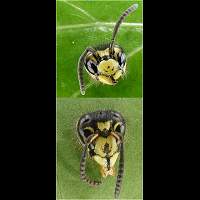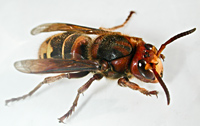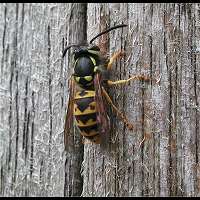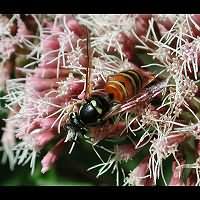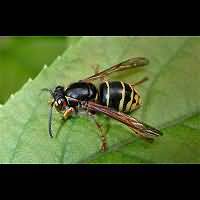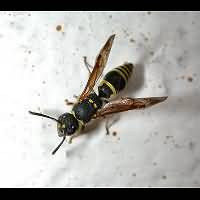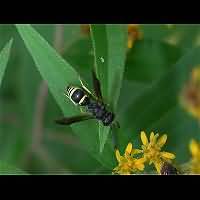[All pictures of garden wildlife on this page are thumbnails. Click on any thumbnail for a large format to be displayed.]
Wasps Vespidae
The best known wasps belong to this family, also known as True Wasps. All British species fold their wings when not flying. This means the wing is folded in the length. This way they look much more narrow and often darker. All wasps are black with yellow (sometimes whitish) or reddish brown markings. On the abdomen the markings usually are represented by one or more lines running from side to side. True Wasps also have remarkable eyes. They are kidney-shaped and rather big. This family is divided into two subfamilies represented in Britain:
1 Social Wasps, also known as Paper Wasps
2 Mason Wasps, also known as Potter Wasps
The best known wasps belong to this family, also known as True Wasps. All British species fold their wings when not flying. This means the wing is folded in the length. This way they look much more narrow and often darker. All wasps are black with yellow (sometimes whitish) or reddish brown markings. On the abdomen the markings usually are represented by one or more lines running from side to side. True Wasps also have remarkable eyes. They are kidney-shaped and rather big. This family is divided into two subfamilies represented in Britain:
1 Social Wasps, also known as Paper Wasps
2 Mason Wasps, also known as Potter Wasps
Social Wasps Vespinae
The Social Wasps are also known as Paper Wasps, because they construct their nest out of a kind of paper they produce themselves by chewing on wood. For Britain this works fine, but in most of the world there is a second subfamily living socially, the so-called Field Wasps (Polistinae). And the members of this family also produce paper to construct the nest. And to add to the confusion: Americans have yet another definition of Paper Wasp. All Social Wasps build nests in which a few hundred up to many thousands animals live together. Such a colony is founded by a single queen in spring. She makes a little nest and lays a few eggs. When those hatch, she has to get food for the larvae. But after pupation the young take over these tasks: they hunt and keep on constructing the nest. The queen is only there to lay eggs. All these kids are unfertile females, which we call workers. Once the nest is full grown some eggs get extra attention and food. The wasps coming out of these cells are bigger and maybe male or female. These females are fertile and thus new queens. After mating the drones, as the males are referred to, die soon. The new queens fly off to find a place to overwinter. The colony now falls apart and workers fly about aimlessly and also die rather soon. The terrible wasps visiting us in autumn and stealing our lemonade and ice cream are social wasps as well. Actually only two species pester us: the Common Wasp and the German Wasp. But because all wasps are very similar indeed, most are killed on sight. However very few species do sting readily. The others are aggressive only in the vicinity of the nest
The Social Wasps are also known as Paper Wasps, because they construct their nest out of a kind of paper they produce themselves by chewing on wood. For Britain this works fine, but in most of the world there is a second subfamily living socially, the so-called Field Wasps (Polistinae). And the members of this family also produce paper to construct the nest. And to add to the confusion: Americans have yet another definition of Paper Wasp. All Social Wasps build nests in which a few hundred up to many thousands animals live together. Such a colony is founded by a single queen in spring. She makes a little nest and lays a few eggs. When those hatch, she has to get food for the larvae. But after pupation the young take over these tasks: they hunt and keep on constructing the nest. The queen is only there to lay eggs. All these kids are unfertile females, which we call workers. Once the nest is full grown some eggs get extra attention and food. The wasps coming out of these cells are bigger and maybe male or female. These females are fertile and thus new queens. After mating the drones, as the males are referred to, die soon. The new queens fly off to find a place to overwinter. The colony now falls apart and workers fly about aimlessly and also die rather soon. The terrible wasps visiting us in autumn and stealing our lemonade and ice cream are social wasps as well. Actually only two species pester us: the Common Wasp and the German Wasp. But because all wasps are very similar indeed, most are killed on sight. However very few species do sting readily. The others are aggressive only in the vicinity of the nest
Genera of Social Wasps
The Social Wasps in Britain belong to either one of three genera. The first, Vespa, doesn't give us any problem. It has one species only: the Hornet. This species is unmistakable because of size and the red markings on head and thorax. The other wasps are either Long-headed Wasps or Short-headed Wasps. One could write a lot about the differences between the two groups, but the picture to the left actually tells all. The Dolichovespula-species have very long cheeks, while the Vespula-species have very short cheeks. That is why their face is small and round. Dolichovespula-species hardly ever sting. The commonly stinging species, the German Wasp and the Common Wasp both are short-headed.
The Social Wasps in Britain belong to either one of three genera. The first, Vespa, doesn't give us any problem. It has one species only: the Hornet. This species is unmistakable because of size and the red markings on head and thorax. The other wasps are either Long-headed Wasps or Short-headed Wasps. One could write a lot about the differences between the two groups, but the picture to the left actually tells all. The Dolichovespula-species have very long cheeks, while the Vespula-species have very short cheeks. That is why their face is small and round. Dolichovespula-species hardly ever sting. The commonly stinging species, the German Wasp and the Common Wasp both are short-headed.
Hornet Vespa crabro
The queen of the Hornet is a formidable animal. This species is the only social wasp on the wing in the dark and is sometimes attracted to light. More...
The queen of the Hornet is a formidable animal. This species is the only social wasp on the wing in the dark and is sometimes attracted to light. More...
Common Wasp Vespula vulgaris
The Common Wasp may be a nuisance by the end of summer. And often there are a lot of them, for one nest may hold over 12,000 animals! More...
The Common Wasp may be a nuisance by the end of summer. And often there are a lot of them, for one nest may hold over 12,000 animals! More...
German Wasp Vespula germanica
The German Wasp often is as big a nuisance as the Common Wasp is. More...
The German Wasp often is as big a nuisance as the Common Wasp is. More...
Red Wasp Vespula rufa
The Red Wasp is among the friendliest of wasps and must be provoked badly before it stings. The sting is extremely painful, though. More...
The Red Wasp is among the friendliest of wasps and must be provoked badly before it stings. The sting is extremely painful, though. More...
Saxon Wasp Dolichovespula saxonica
The Saxon Wasp is new to Britain and found in Southern England only. More...
The Saxon Wasp is new to Britain and found in Southern England only. More...
Cuckoo Wasp Dolichovespula adulterina
This Cuckoo Wasp is lazy and abuses the Saxon Wasp. This is a non British species, but it could appear any minute now the Saxon Wasp has reached England. More...
This Cuckoo Wasp is lazy and abuses the Saxon Wasp. This is a non British species, but it could appear any minute now the Saxon Wasp has reached England. More...
Median Wasp Dolichovespula media
The Median Wasp is quite variable, but usually the darkest of all Social Wasps. More...
The Median Wasp is quite variable, but usually the darkest of all Social Wasps. More...
European Paper Wasp or Dominulus Paper Wasp Polistes dominula
Polistes dominula is a member the Vespidae family, the Social Wasps that live in small communities. Unlike other True Wasps wasps they is not attracted to the limonade and desserts... More...
Polistes dominula is a member the Vespidae family, the Social Wasps that live in small communities. Unlike other True Wasps wasps they is not attracted to the limonade and desserts... More...
Mason Wasps Eumeninae
The Mason Wasps differ from the Social Wasps in many respects. The female builds a nest individually and just for herself. The wasps do not cooperate and there are no queens and workers. The abdomen always starts of slenderly, which gives the animals a beautiful wasp waist. Most Mason Wasps make chambers in cavities in dead wood or hollow reet. These chambers are stuffed with paralyzed caterpillars or beetle larvae. The female deposits her egg on top and then seals off the chamber, by masoning a small wall. One cavity may hold several chambers. There are some genera of Mason Wasps and each is comprised of many species. It is impossible to name each species in the field. You will need a magnifying glass or even a microscope to do that. Usually however it is possible to name the genus in the field.
The Mason Wasps differ from the Social Wasps in many respects. The female builds a nest individually and just for herself. The wasps do not cooperate and there are no queens and workers. The abdomen always starts of slenderly, which gives the animals a beautiful wasp waist. Most Mason Wasps make chambers in cavities in dead wood or hollow reet. These chambers are stuffed with paralyzed caterpillars or beetle larvae. The female deposits her egg on top and then seals off the chamber, by masoning a small wall. One cavity may hold several chambers. There are some genera of Mason Wasps and each is comprised of many species. It is impossible to name each species in the field. You will need a magnifying glass or even a microscope to do that. Usually however it is possible to name the genus in the field.
Symmorphus crassicornis, a Mason Wasp
Symmorphus crassicornis is a very common species in many gardens. More...
Symmorphus crassicornis is a very common species in many gardens. More...

© Copyright 1998-2024 gardensafari.net (Hania Berdys)

 English / engels
English / engels  Dutch / nederlands
Dutch / nederlands